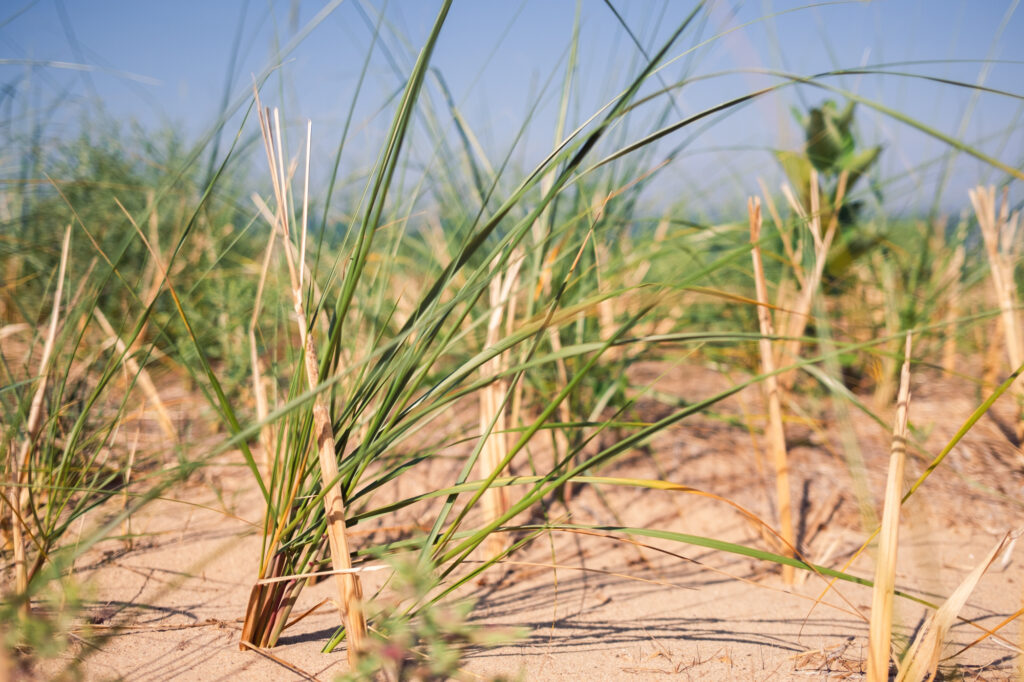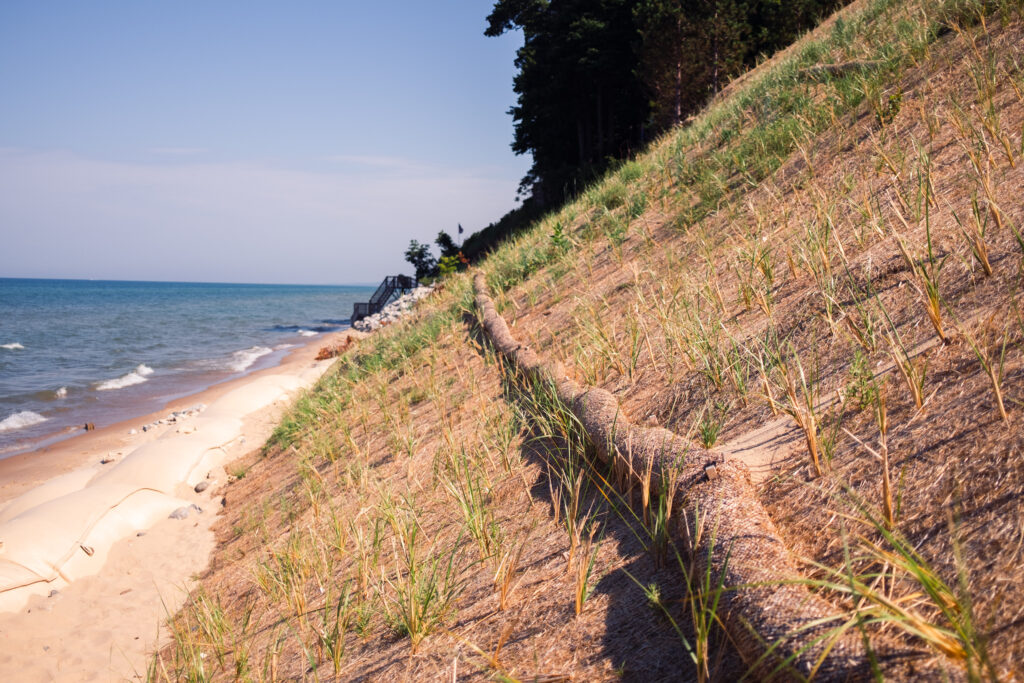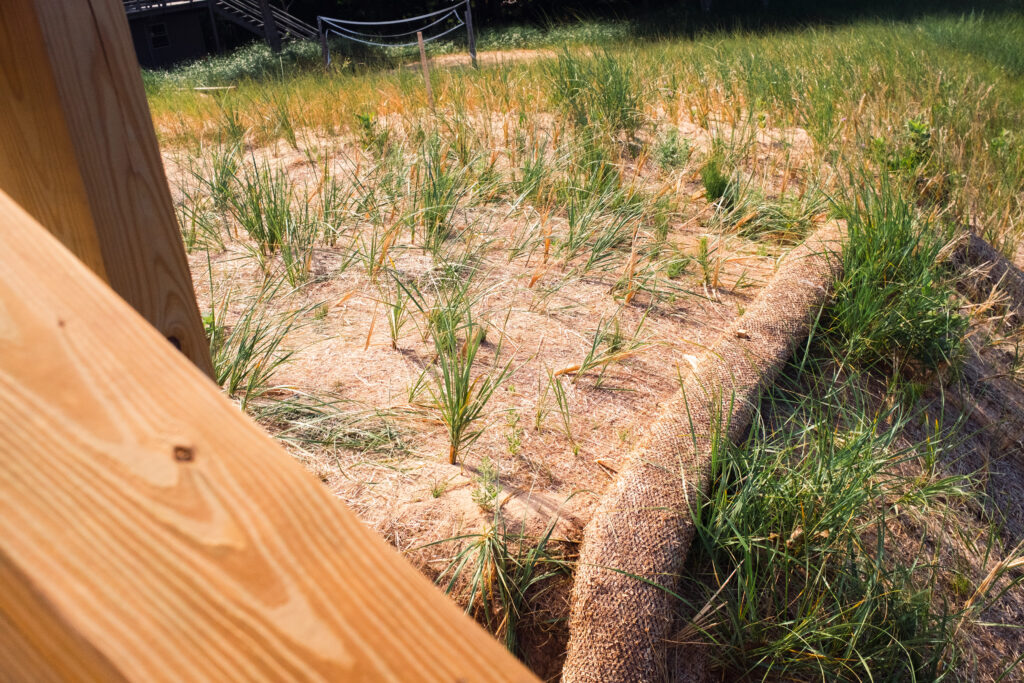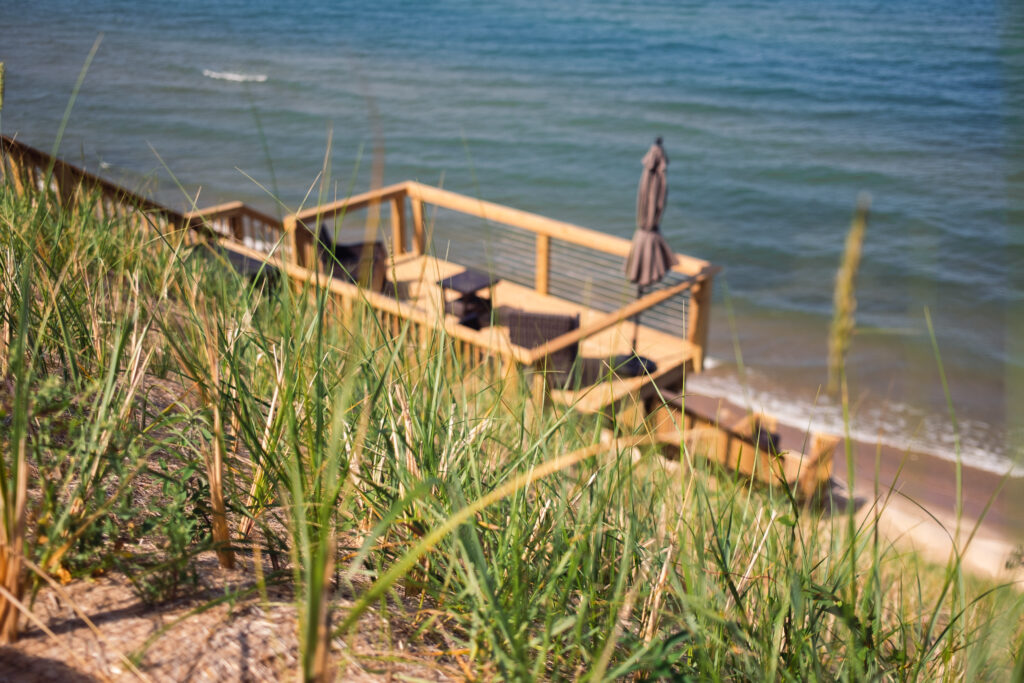The Great Lakes shoreline is an actively eroding coast. These high-risk erosion areas (HREAs) have been eroding at an average rate of one foot or greater per year over at least 15 years. Does your Lake Michigan property need protecting? Beach grass might just be the solution you need.
Beach grass is a key player in keeping your property’s erosion at bay. The roots act as a net to hold your sandy areas together. And when the wind blows, sand will catch and collect around the base, eventually helping to build and strengthen your dunes.
And while beach grass is necessary for those high-erosion areas, it’s also perfect for your flat sandy areas! We believe dune grass is more than just a preventative measure—it’s a beautiful design choice when landscaping your property too!
No matter the reason you choose to plant beach grass, we’re here to help!

Types of Beach Grass
Ammophila breviligulata (American beachgrass) is native to eastern North America, where it grows on sand dunes along the Atlantic Ocean and Great Lakes coasts.
American Native Beach Grass
Native beach grass was established on the shores of the lakes throughout the Great Lakes basin from Duluth, Minnesota to Buffalo, New York. Native Beach grass can be planted on the northern half of the Atlantic coast and has been planted successfully on the Pacific NW coast.
American Native is a green variety of beach grass that grows to be about 3 feet tall. It’s leafy, with many stems per clump, and establishes with ease. The leaves are long and narrow and could become rolled or folded as it matures.
‘Cape’ American Beach Grass
‘Cape’ American Beach Grass was selected from Cape Cod, Massachusetts. While the ‘Cape’ selection was specifically developed for the Atlantic coast from Maine to North Carolina, it also grows vigorously in the Great Lakes basin.
‘Cape’ American is a blue-green variety of beach grass that also grows to be about 3 feet tall. But what sets ‘Cape’ American apart from American Native Beach Grass is its wider leaves and its ability to produce multiple stems. Those characteristics combine to provide strong sand-trapping abilities.
Beach Grass Planting Season in Michigan
Fall is the best time to plant beach grass. The fall planting season in West Michigan begins around October 15 and goes until the soil freezes.
Spring is the second-best time to plant beach grass. The spring planting season in West Michigan runs from March to around May 15. The seedlings will have difficulty establishing any time after that because the temperatures are too hot and the conditions are too dry.
NOTE: In Spring, the grass will be dormant at harvest. You can expect the blades of grass to start emerging 3 to 4 weeks after planting. Always make sure you plant the grass 10 inches deep (or more) so the grass can survive a dry, hot summer.

Preparing Your Property for Beach Grass
Does your property need debris removal services?
Removing debris from your shoreline and dunes clears the slate. If excess debris is not removed, new foliage and plants will not be able to grow because the debris will be in the way. Allowing for the debris to be removed is what will allow for vegetation like beach grass to properly take root.
Learn more about debris removal.
Does your property need an erosion control blanket?
The job of erosion control blankets is to prevent soil or sand shifting and promote vegetation growth, whether on a flat surface or on steep dunes. They prevent erosion from worsening by keeping the existing sand or soil in place and creating an environment for new vegetation or foliage to take root.
When used in conjunction with beach grass, erosion control blankets work to hold the new plants where they are and keep them protected and covered, while still allowing them the water and sunlight that they need.
How to Plant Beach Grass
When it comes to easy planting, we recommend using beach grass plugs. Beach grass plugs typically have an extensive root system because they’ve been growing for a season in a plug tray. This gives your beach grass a head start when establishing itself in the sand. Using beach grass plugs also allows for planting to be done a little bit later into the season.
Four Easy Steps
Step 1: Create a hole somewhere between 8 to 10 inches deep with a narrow trowel or dowel. (8 to 10 inches is the ideal depth for planting beach grass because it ensures that it won’t dry out or be blown out by the wind.)
Step 2: Place one beach grass plug into the hole you’ve just made.
Step 3: Press next to the plant to firm the sand and cover the roots.
Step 4: If rain is not in the forecast for the first two weeks, make sure you water the new beach grass frequently to promote growth.
How far apart should beach grass be spaced?
- Steep Slopes: 6 inches apart – 4 per square foot
- Moderate Slopes: 8 inches apart – 2 per square foot
- Flat Ground: 12 inches apart – 1 per square foot
- Flat Ground (Economy): 18 inches apart – 1 per two square feet

Planting Tips
- Plant From the Top Down
- For slopes, it’s important that you always plant from the top down in order to avoid walking through the planted grass.
- Plant Immediately After Rain
- If possible, plant your beach grass immediately after it rains because the wet sand will maintain the hole better than dry sand.
- Use Fertilizer
- Dune Grass typically does alright without fertilizer, but it could be helpful for early spring root growth.
Beach Grass Planting Services at Lakeshore Customs
As easy as it is to install beach grass, it can be a big job! At Lakeshore Customs, we not only install dune grass for erosion control, but also a variety of native trees, bushes, and vegetation to help you with any of your landscaping needs!
We can also help with any landscaping preparation that your property requires. Before beach grass can be planted, it’s important to clear your property of any debris. And if your property needs more erosion control, you might want to consider our erosion control blankets before planting.
At Lakeshore Customs, we strive to restore, protect, and beautify your lakeshore property. Contact us to set up your service today!

